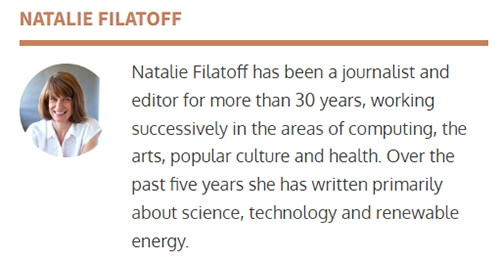


青松系企业QE-Labs获pv magazine报道 | 澳大利亚首例:光伏EL检测实现“空中方案”
2023-11-04 14:49:40
2023年10月30日,青松系企业QE-Labs(量化能源实验室,Quantified Energy Labs Pte. Ltd)获全球新能源行业权威杂志pv magazine专访报道——Australian First: EL solar panel inspection takes to the skies(澳大利亚首例:光伏EL检测实现“空中方案”)。
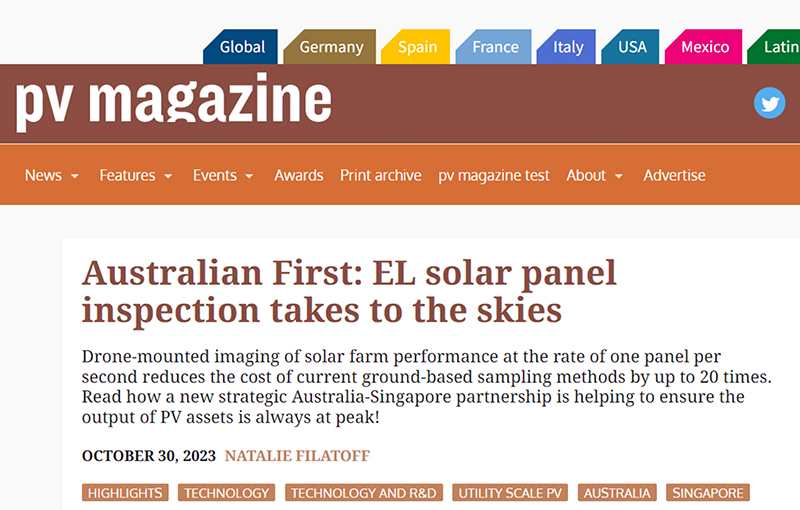
pv magazine(www.pv-magazine.com)创办于2008年,是全球领先的光伏和储能领域媒体平台。以英语和德语出版月刊和季刊,并运营多个国际行业新闻频道(全球、德国、法国、西班牙、意大利、美国、墨西哥、巴西、拉丁美洲、澳大利亚、中国和印度)。pv magazine专注于光伏和储能行业,包括新产品和技术、政策和市场发展,以及与光伏和能源转型相关的其他主题。
以下为报道全文
Drone-mounted imaging of solar farm performance at the rate of one panel per second reduces the cost of current ground-based sampling methods by up to 20 times. Read how a new strategic Australia-Singapore partnership is helping to ensure the output of PV assets is always at peak!
OCTOBER 30, 2023 NATALIE FILATOFF
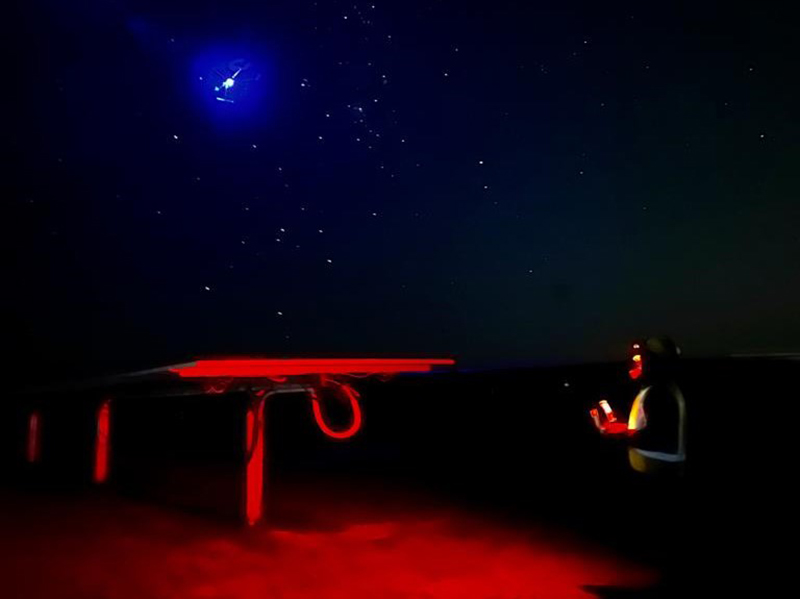
Nocturnal panel testing suits the solar industry down to the ground!
Image: PV Lab
Trusted Australian experts in solar panel performance, Lawrence McIntosh and Michelle McCann at Canberra-based PV Lab, have combined forces with innovators in high-speed electroluminescence imaging at Quantified Energy Labs (QE-Labs) in Singapore, to bring efficient solar panel testing to the Australian utility market at scale.
The technology is vital for testing performance at various points in the solar asset lifecycle: at solar farm commissioning, when it provides a useful baseline; for identifying underperformance before the end of the panel defect liability period; for subsequently verifying to insurers the damage caused by severe weather events; and for verifying performance at any change of ownership of the farm. And of course it pinpoints problems, assists in targeting maintenance and reduces risks such as fire due to faulty panels, throughout the life of the asset.
QE-Labs is a commercial spin-out of technology developed at the Solar Energy Research Institute of Singapore (SERIS), part of the National University of Singapore.
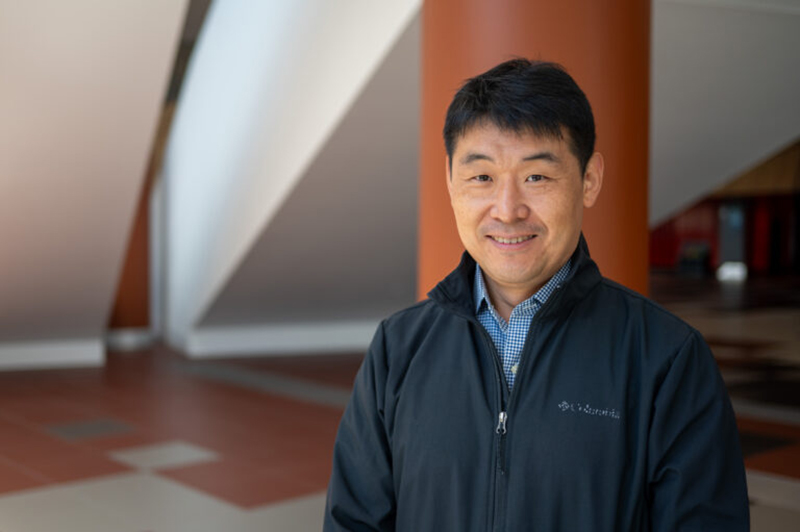
Dr Yan Wang, CEO of QE-Labs talked to pv magazine at the All Energy conference in Melbourne. "I'm a solar guy from day one," he says. "I'm originally from China where I worked in manufacturing of PV panels for seven years. Then I moved to Singapore in 2014 to join the National University, and realised that our industry needs this panel-testing service."
Image: Dave Tacon/pv magazine
"Our team spent a decade researching PV panel technologies, doing indoor testing, and certifying performance and reliability of panels in our tropical Singapore environment", QE-Labs CEO, Dr Yan Wang, told pv magazine Australia at All-Energy in Melbourne last week, "Then developers who were experiencing yield losses started sending us modules from their solar farms for testing."
It wasn't long, says Wang, before all parties realised that this method of bringing panels to the lab was too laborious and time-consuming, which also made it expensive — "the unit price was too high".
Pinpoint accuracy
puts haystack sampling out to pasture
And as McCann points out, the sampling method of nailing underperforming culprits across an entire solar farm was like, "Looking for a needle in a haystack."
Researchers at SERIS realised that electroluminescence (EL) imaging — their preferred inspection technology, which "produces something like an x-ray of the solar panel", explains Wang — could be taken into the field. But how much better would it be, if imaging didn’t have to be set up for each panel?
McIntosh and McCann, working in their Australian lab to assess the performance of panels in the Australian utility solar sector had come to a similar conclusion: "We knew that drones would revolutionise the way we gather data, and if they could be used to take electroluminescence images, we'd be able to bring huge scale to helping asset owners assess the condition of their solar farms," McIntosh told pv magazine Australia.
He and McCann had just decided that developing their own autonomous EL system would not be "commercially smart", when they were introduced by solar colleagues in Germany to QE-Labs. "It's a really good fit," says McCann of the resulting collaboration: "They've got the drones and the tech, and we've got the site experience and the ability to fly and work in Australia."
McIntosh became a licensed commercial drone pilot and began PV Lab's fly-by-night operation. That is to say, another benefit of electroluminescence imaging is that it is carried out in the dark, out of solar-generation hours.
QE-Labs' innovation includes:
1) Integration of a specialised InGaAs fast-image-capture camera with a custom-built long-flight-duration drone, and development of software that compensates for flight wobble, and keeps the drone adjusting to accomplish its mission of capturing a complete image of each panel even if it gets blown off course by wind.
2) Application of AI and quantitative analysis algorithms to sift for anomalies in the tens of thousands of images generated.
3) A user-friendly interface — an app — that allows asset owners to hunt down specific faults such as cracks, faulty solar cells and corrosion. Integrated GPS guides users to the exact faulty panel(s). Inbuilt machine learning also identifies user preferences in the sense that some operators may consider some faults more important to repair than others; a green-amber-red traffic light system indicates performance glitches of low to high importance to individual operators.
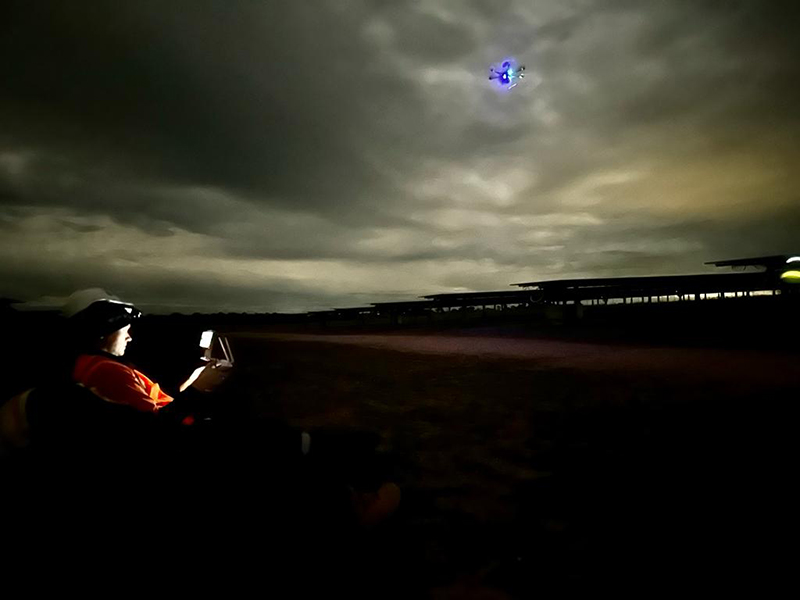
Introducing drone-mounted solar-panel inspection at the All Energy conference in Melbourne, Dr Yan Wang, CEO of QE-Labs explains that during nocturnal EL testing, the solar farm operator injects current through the string DC connector, "which creates light like an LED" and illuminates the panels while the pilot controls the scanning drone.
Image: PV Lab
Among other test cases, in late 2021 QE-Labs completed the world’s largest drone electroluminescence inspection, of 60MWp Sembcorp Tengeh Floating Solar Farm, on Tengeh Reservoir in Singapore. Over two weeks of night shift, it covered a total area of some 45 football fields.
Great for
awkward terrain and floating PV
At the time, Head of Operations and Maintenance at Sembcorp, Willie Soh, praised the accuracy of QE-Labs' work and its "ability to rapidly pinpoint defects in our PV modules, which could have been caused from a variety of factors". He said Sembcorp would continue to use the drone-mounted technology to ensure that its “PV system is running in optimal condition at all times”. The Sembcorp inspections were successfully carried out despite the solar farm being surrounded by public infrastructure that strictly bans the taking of images – negotiating approvals and proving QE-Labs' best-practice use of high accuracy technology were key to this process.
In Australia, PV Lab was keen to prove the efficacy of the QE-Labs platform with a solar farm using an inline fuse system. Says McIntosh, "Inline fuse farms are becoming increasingly popular in Australia and elsewhere, and we wanted to demonstrate the technology would work in that context. So we developed a kind of new logistical solution to actually image each individual string."
The inspection was of a 45,000-module solar plant at the end of its defect liability period. Although the facility wants to remain anonymous, the plant operations and asset manager said, "The ability of drone EL mapping to accurately pinpoint problematic modules is a game changer for us," allowing the operator to selectively replace "worst-performing modules wherever they are in the plant", which results in "significant improvement of the overall system performance", and maximises energy output.
本文作者:Natalie Filatoff
